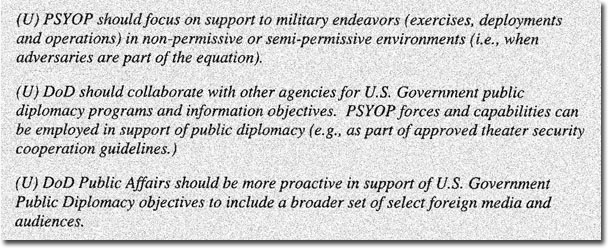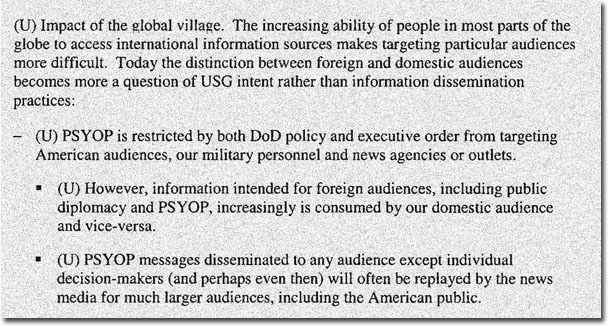|
|
Washington,
D.C., January 26, 2006 - A secret Pentagon
"roadmap"
on war propaganda, personally approved by Secretary
of Defense Donald Rumsfeld in October 2003, calls for "boundaries"
between information operations abroad and the news media at home,
but provides for no such limits and claims that as long as the American
public is not "targeted," any leakage of PSYOP to the
American public does not matter.
Obtained under the Freedom of Information Act by the National
Security Archive at George Washington University and posted on
the Web today, the 74-page "Information
Operations Roadmap" admits that "information
intended for foreign audiences, including public diplomacy and
PSYOP, increasingly is consumed by our domestic audience and vice-versa,"
but argues that "the distinction between foreign and domestic
audiences becomes more a question of USG [U.S. government] intent
rather than information dissemination practices."
The Smith-Mundt Act of 1948, amended in 1972 and 1998, prohibits
the U.S. government from propagandizing the American public with
information and psychological operations directed at foreign audiences;
and several presidential directives, including Reagan's NSD-77
in 1983, Clinton's PDD-68 in 1999, and Bush's NSPD-16 in July
2002 (the latter two still classified), have set up specific structures
to carry out public diplomacy and information operations. These
and other documents relating to U.S. PSYOP programs were posted
today as part of a new Archive Electronic Breifing Book.
Several press accounts have referred to the 2003 Pentagon document
but today's posting is the first time the text has been publicly
available. Sections of the document relating to computer network
attack (CNA) and "offensive cyber operations" remain
classified under black highlighting.
Rumsfeld's
Roadmap to Propaganda
National
Security Archive Electronic Briefing Book No. 177
Edited
by Kristin Adair
Posted
- January 26, 2006
The Information
Operations Roadmap, a 30 October 2003 document approved
personally by Secretary of Defense Donald Rumsfeld, "provides
the Department with a plan to advance the goal of information operations
as a core military competency" and "stands as an another
example of the Department's commitment to transform our military
capabilities to keep pace with emerging threats and to exploit new
opportunities afforded by innovation and rapidly developing information
technologies." The plan was developed by an oversight panel
led by the Deputy Assistant Secretary of Defense (Resource and Plans)
and representatives from the Joint Staff, Office of the Secretary
of Defense, and Special Operations Command, among other organizations.
 |
The
Roadmap was personally approved by Secretary of Defense
Donald Rumsfeld.
|
|
The Roadmap presents as one of its key assumptions the importance
of Psychological Operations (PSYOP), particularly in wartime: "Effectively
communicating U.S. Government (USG) capabilities and intentions
is an important means of combating the plans of our adversaries.
The ability to rapidly disseminate persuasive information to diverse
audiences in order to directly influence their decision-making is
an increasingly powerful means of deterring aggression. Additionally,
it undermines both senior leadership and popular support for employing
terrorists or using weapons of mass destruction." The military
defines PSYOP generally as "planned operations
to convey selected information and indicators to foreign audiences
to influence the emotions, motives, objective reasoning, and ultimately
the behavior of foreign governments, organizations, groups, and
individuals."
The Roadmap has been cited in the media several times (see James
Bamford, "The Man Who Sold the War: Meet John Rendon, Bush's
general in the propaganda war," Rolling Stone, November
17, 2005; Stephen J. Hedges, "Media use backfires on U.S.;
Many ask if Pentagon altered information to make case for war,"
Chicago Tribune, December 11, 2005.) [see
references], but has not previously been released to
the public. The document calls on DoD to enhance its capabilities
in five key Information Operations (IO) areas: electronic warfare
(EW), PSYOP, Operations Security (OPSEC), military deception and
computer network operations (CNO).
In light of recent media coverage of alleged propaganda activities
by the military in Iraq, the Roadmap gives as one of its recommendations
the need to "Clarify Lanes in the Road for PSYOP, Public Affairs
and Public Diplomacy." The U.S. government is legally prohibited
from conflating these operations by targeting PSYOP activities--intended
for foreign audiences--at the American public. 22
U.S.C. § 1461 (Smith-Mundt Act), which created
the United States Information Agency (USIA) in 1948, directs that
information about the United States and its policies intended for
foreign audiences "shall not be disseminated within the United
States, its territories, or possessions." Amendments to the
Smith-Mundt Act in 1972 and 1998 further clarified the legal obligations
of the government's public diplomacy apparatus and several presidential
directives, including Reagan's
NSD-77 in 1983, Clinton's
PDD-68 in 1999, and Bush's
NSPD-16 in July 2002 (the latter two still classified),
have set up specific structures and procedures, as well as further
legal restrictions, regarding U.S. public diplomacy and information
operations.
President Clinton's
secret Presidential Decision Directive (PDD-68), issued
on April 30, 1999, expanded public diplomacy and public affairs
operations beyond USIA and the Department of State to include all
agencies and set out the objective of IPI "to synchronize the
informational objectives, themes and messages that will be projected
overseas . . . to prevent and mitigate crises and to influence foreign
audiences in ways favorable to the achievement of U.S. foreign policy
objectives." (PDD-68 also cautioned against using the new information
operations to influence the American public, but recognized the
potential for "backwash" of IPI information to the United
States and so called for coordinated domestic and foreign public
affairs operations to synchronize foreign policy messages.
The newly-released Information Operations Roadmap, with the goal
of expansion and central coordination of Pentagon PSYOP and public
diplomacy operations, also recognizes the legal conundrum presented
by the use of overseas propaganda in the information age. But while
the document recognizes the need for boundaries-referred to as "[l]anes"-between
U.S. public diplomacy and foreign propaganda, it fails to provide
any such limits:
"The likelihood that PSYOP messages will be replayed
to a much broader audience, including the American public, requires
that specific boundaries be established for PSYOP. In particular:

The discussion of the relationship between public diplomacy and
IO neither cites the applicable legal restrictions nor institutes
specific guidelines, but references only the "intent"
of the U.S. government in "targeting" either foreign or
domestic audiences:

By means of recommendations for enhancing PSYOP capabilities, the
oversight panel directed "improvements . . . to rapidly generate
audience specific, commercial-quality products into denied areas"
and a "focus on aggressive behavior modification at the operational
and tactical level of war." Additionally, the Roadmap cites
improved military support to public diplomacy efforts and support
for "active public affairs programs that influence foreign
audiences" as vital components of the new IO strategy.
Documents
Note: The following documents are in PDF format.
You will need to download and install the free Adobe
Acrobat Reader to view. Document
1: Department of Defense, Information Operations Roadmap, October
30, 2003, Secret [Excised].
Source: Freedom of Information Act request
Document
2: Joint Publication 3-53, Doctrine for Joint Psychological
Operations, September 5, 2003.
Source: http://www.dtic.mil/doctrine/jel/new_pubs/jp3_53.pdf
Document
3: National Security Decision Directive NSDD-77, "Management
of Public Diplomacy Relative to National Security," January
14, 1983.
Source:
Freedom of Information Act request.
Document
4: Reorganization Plan and Report, Submitted by President Clinton
to the Congress on December 30, 1998, Pursuant to Section 1601 of
the Foreign Affairs Reform and Restructuring Act of 1998, as Contained
in Public Law 105-277.
Source: http://www.fas.org/irp/offdocs/pdd/pdd-68-dos.htm
Document
5: Presidential Decision Directive PDD-68, "International
Public Information (IPI), April 30, 1999 [Classified].
Source: Summary from Steven Aftergood, Federation
of American Scientists, http://www.fas.org/irp/offdocs/pdd/pdd-68.htm,
citing IPI Core Group Charter, obtained by the Washington Times
(Ben Barber, "Group Will Battle Propaganda Abroad," Washington
Times, 28 July 1999).
Document
6: National Security Presidential Directive NSPD-16, July 2002
[Classified].
Source: Summarized in Power Point presentation on
Information Warfare, Florida International University, 2004, http://www.fiu.edu/~apodaca/Information%20Warfare%20Lecture.ppt
REFERENCES
James
Bamford, "The Man Who Sold the War: Meet John Rendon, Bush's
general in the propaganda war," Rolling Stone, November
17, 2005, available at http://www.rollingstone.com/politics/store/_/id/8798997.
Stephen
J. Hedges, "Media use backfires on U.S.; Many ask if Pentagon
altered information to make case for war," Chicago Tribune,
December 11, 2005.
Col.
Sam Gardiner (USAF, Ret.), "Truth
from These Podia: Summary of a Study of Strategic Influence, Perception
Management, Strategic Information Warfare and Strategic Psychological
Operations in Gulf II," October 8, 2003, also available
at http://www.usnews.com/usnews/politics/whispers/documents/truth_1.pdf.
Ltc.
Susan L. Gough, "The
Evolution of Strategic Influence, U.S. Army War College Strategy
Research Project," April 7, 2003, also available at http://www.fas.org/irp/eprint/gough.pdf.
|

